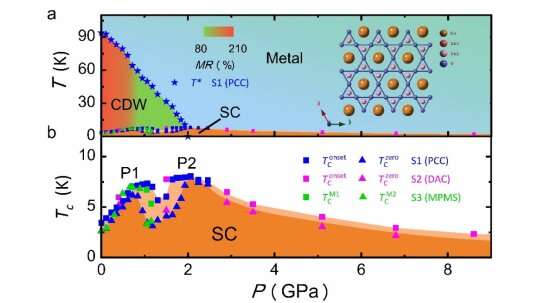Researchers discover unusual competition between charge density wave and superconductivity

A research team led by Prof. Chen Xianhui from University of Science and Technology of China of the Chinese Academy of Sciences (CAS) found an unusual competition between charge density wave (CDW) and superconductivity in CsV3Sb5, a layered kagome metal, which provides key experimental evidence for understanding novel CDW and superconductivity. The result was published in Nature Communications and recommended as featured article.
Traditional superconductivity and CDW are two different electronic states, which both originate from electron phonon coupling and Fermi instability. In the conventional coexistence image of CDW and superconductor, after entering the CDW state, the energy gap is opened due to the nesting of Fermi surface, resulting in the loss of density of states, showing the behavior of CDW competing with superconductors.
CDW status can be suppressed by increasing pressure or chemical doping. With the suppression of CDW state, the superconducting critical transition temperature (Tc) will show a single dome like behavior. Due to the strong geometric frustration, more novel quantum states, including unconventional superconducting states and chiral density waves, are predicted.
Recently, a novel layered cage structure superconductor CsV3Sb5 has been discovered, which has a CDW transition temperature of 94 K. Combined with a variety of pressure means, the researchers carried out pressure control research on it, and determined the phase diagram of the material under high pressure.
Through measurement of high voltage electric transport and magnetic susceptibility, they found that Tc behaves as a double dome with the increase of pressure, rather than a traditional single dome. When the pressure is between 0.7 GPa and 2 GPa, the samples show abnormal Tc suppression and superconducting broadening. When the pressure reaches 2 GPa, the CDW is completely compressed, and the Tc can reach up to 8 K (three times of that at normal pressure), which is also the highest Tc reported for materials with cage structure.
The anomalous double dome superconducting phase diagram may be caused by the transition from commensurate CDW state to nearly commensurate CDW state. Therefore, the results show that the superconducting state and CDW state of CsV3Sb5 are very sensitive to pressure, showing abundant pressure phase diagrams.
This study also reveals the unusual competition between superconductivity and CDW in CsV3Sb5, which provides experimental clues for studying the unconventional CDW mechanism.
More information: F. H. Yu et al, Unusual competition of superconductivity and charge-density-wave state in a compressed topological kagome metal, Nature Communications (2021). DOI: 10.1038/s41467-021-23928-w
Journal information: Nature Communications
Provided by Chinese Academy of Sciences





















